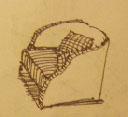Chapter 6 Processes, Threads, and Jobs
Posted on 2009-12-15 12:55 S.l.e!ep.¢% 閱讀(296) 評論(0) 編輯 收藏 引用 所屬分類: English
翻譯了老半天,真想買一本中文的看....
Chapter 6
Processes, Threads, and Jobs
In this chapter, we’ll explain the data structures and algorithms that deal with processes,
threads, and jobs in Microsoft Windows.
在這一章,我們將解釋
Microsoft Windows
內部處理
進程、線程和作業的數據結構和算法
explain: 解釋
The first section focuses on the internal structures
that make up a process. The second section outlines the steps involved in creating a process
(and its initial thread).
第一節集中介紹構成一條進程的內部結構
.
第二節概述創建一條進程(以及它的初始線程)的涉及的步驟
focus on: 關注
make up: 構成
outline. v. 概述
involve in 使參與
The internals of threads and thread scheduling are then described. The
chapter concludes with a description of the job object.
然后,介紹了線程的內部和線程的調度機制
.
最后還講到
job
對象
Internal: 內部的
Scheduling 時序安排
Conclude 中止
Conclude with 以 … 結束 / 中止
Where relevant performance counters or kernel variables exist, they are mentioned. Although
this book isn’t a Windows programming book, the pertinent process, thread, and job Win-
dows functions are listed so that you can pursue additional information on their use.
相關的性能計數器和存在的內核變量都會提及。雖然這本書不是
Windows
編碼的書,相關的進程,線程和工作的
windows
函數會列出來,所以你可以去查閱它們使用的相關信息
Relevant??? 有關的,相關的
Mentioned?? mention 的過去式 ? 提到,提及
Pertinent??? adj, 相關的
Pursue????? v, 追求
Although??? 雖然
Because processes and threads touch so many components in Windows, a number of terms
and data structures (such as working sets, objects and handles, system memory heaps, and so
on) are referred to in this chapter but are explained in detail elsewhere in the book.
To fully understand this chapter, you need to be familiar with the terms and concepts explained in
chapters 1 and 2, such as the difference between a process and a thread, the Windows virtual
address space layout, and the difference between user mode and kernel mode.
Process Internals
This section describes the key Windows process data structures. Also listed are key kernel
variables, performance counters, and functions and tools that relate to processes.
Data Structures Each Windows process is represented by an executive process (EPROCESS) block. Besides containing many attributes relating to a process, an EPROCESS block contains and points to a number of other related data structures. For example, each process has one or more threads represented by executive thread (ETHREAD) blocks. (Thread data structures are explained in the section “Thread Internals” later in this chapter.) The EPROCESS block and its related data structures exist in system space, with the exception of the process environment block (PEB), which exists in the process address space (because it contains information that is modified by user-mode code).




